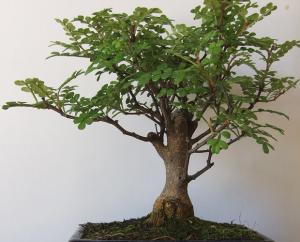Elephant Tree is an interesting houseplant
Elephants recognize and can keep track of as many as 30 herd mates at a time. With a lifespan of up to 80 years, it makes sense that elephants really do have great memories. So it's great that their namesake Elephant Tree plants (Operculicarya decaryi) can thrive even when we forget them. As succulents, Elephant Trees can go for long periods without water.
They're called Elephant Trees because of their shiny gray bark and gnarled trunks. With tiny leaves that can make the tree look like a true miniature, these are often used in bonsai. In their native Madagascar these slow-growing, deciduous trees can reach up to 30 feet tall, but when grown indoors in a large pot, they will stay manageably small, only getting up to three or four feet tall. In late winter the mature trees bloom with clusters of six or so tiny, dark-red flowers.
This potted tree often grows into a natural bonsai with a fat trunk and roots that poke out of the soil, exposing gnarly, twisted elephantine designs. Because the green or bronze leaves are so small, they are in perfect proportion to the tree to create the illusion of a large, full-grown tree shrunk down to miniature. While Elephant Trees (also called Jabily) prefer partial to full sun, don't let them get too hot or dry out. Filtered light is best.
Water them only when the soil is dry. The key is to remember that they grow well in gravelly, poor soil that drains rapidly. Plant them in a quick-draining potting soil that contains up to half inorganic filler such as sand or perlite. Use a slow-release fertilizer in moderation. Avoid the temptation to overpot, that is, to put them into a pot that is too big. A small pot that confines the roots will make them grow with thicker trunks. If you repot them, use a container that is just an inch larger.
You can propagate Operculicarya decaryi from seeds or cuttings. Plants grown from seeds tend to produce better-looking roots and have more interesting traits, such as very lumpy and more fascinating bumpy trunks. Elephant Tree plants are dioecious, with male and female flowers growing on separate plants. So you will need both a male and female plant to bloom and set seeds. The seeds are formed in small, yellow-orange or slightly red fruits. Let the quarter-inch seeds mature to a deep purple before harvesting them. You can also propagate them from root cuttings or stem cuttings. Stem cuttings often root in plain water. They are only hardy in the warmest climates, USDA zones 9-11, so for most gardeners this is strictly an indoor plant.
For an interesting houseplant that needs little care, try growing your own Elephant Tree. It will thrive indoors in bright light, with a sparse watering schedule. They thrive even when we very un-elephantine humans tend to forget.




















































